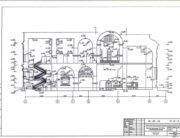Scientific and project documentation on the sights of history and culture (DBN V.3.2-1-2004) is the basis for all repair and restoration works on monuments of architecture. This document contains monuments of history, archeology, urban planning and architecture, as well as monuments of art directly related to the monuments of architecture. The documentation establishes the composition, order of development, design, coordination and approval of an integrated complex of scientific and research and design and estimate documentation for architectural and engineering works.
Restoration of monuments of history and culture provides for the strengthening and restoration of destroyed, damaged monuments, as well as their transfer in order to preserve the historical and artistic value. The restoration provides for the following types of work:
- fragmentary restoration (including partial reproduction)
- holistic restoration (including full reproduction).
Preservation of monuments provides for the preservation of monuments in the form in which they have survived to our days, and the following types of work:
- priority emergency response work with the implementation of temporary measures to ensure the preservation of monuments;
- measures for the preservation of architectural and artistic elements of monuments;
- ydrogeological measures to create appropriate conditions for the preservation of monuments.
Repair of historical and cultural monuments provides for the improvement of the technical condition and performance of monuments without altering the existing architectural appearance.
One of the main problems is the restoration of the original form completely or almost completely destroyed. Successfully this problem of reconstruction – recreation decided in the cities of Poland. At the same time, to a certain extent, we can assume that in Ukraine the foundations of this process were based back in antiquity: outstanding masterpieces were repeatedly destroyed and restored and updated many times, although without directly repeating the original principle. The reconstruction of the church of St. Basil in Ovruch with the use of studying analogues of ancient Russian architecture was engaged in the beginning of the XX century and A. Schusev. In recent decades, the practice of recreating outstanding structures has become widespread abroad. Such works are perhaps the most difficult branch of modern restoration, because they have the goal of reproducing an object that does not exist at the moment, therefore, should be recreated based on the study of archaeological data, archival sources and based on the study of analogs and be as close to authentic attractions, not turning into a regular “replica.”
Another restoration problem is the compatibility and interaction of new building materials, structures and technologies with authentic ones; therefore, during the technological inspection of the monument, a thorough study of its building materials, structures, painting and interior objects is carried out and laboratory studies are conducted to determine the chemical and petrographic composition of building materials, stratigraphic analysis, determined by the presence of moisture in the clutch, and the like. Field surveys and laboratory studies are the basis for the creation of technology “carrying out repair and restoration work” and the selection of materials that are most compatible with the original materials of the attraction.
If we list the main mistakes that were made during the repairs of monuments before the beginning of the 20th century, this list would look as follows:
in general, the term architectural monument did not exist, and the restoration of the status of outstanding objects was approached as usual repairs;
there were no concepts of “restoration” and “conservation” in their modern meaning, they did not understand the value of conservation, which provides for the maximum preservation of the authenticity of the monument, minimal interference with its appearance and is the basis for the restoration;
Restoration of monuments was not conducted at the proper professional level, nonprofessionals were involved in the restoration of monuments, due to which many structures were destroyed and damaged;
- the register of monuments was not compiled, the value of many objects that did not correspond to the official doctrine of Orthodoxy, autocracy and nationality and neoclassical and Russian-Byzantine style trends in architecture and art of the XIX century was not understood;
- the causes of the emergency state of the monuments were not discovered, and therefore methods for the restoration of monuments based on scientific principles were not developed either.
Today, experts have developed a methodology for overcoming problems arising from the exploitation of monuments. First of all, these are the following problems:
- the loss of the foundations of their bearing capacity;
- preservation of remains of ancient masonry in archaeological excavations;
- emergency condition of the walls;
- restoration of damaged or destroyed wooden elements and structures;
- preservation of metal roofs, roofs and renovations of gilding tops;
- problems of updating the decorative trim.
Restoration techniques were also developed by domestic specialists of the corporation Ukrrestavratsiya, where the leader of the technologists team of the institutes Ukrproektrestavratsiya (now they are concentrated in the State Scientific-Technological Laboratory for Conservation and Restoration).



















